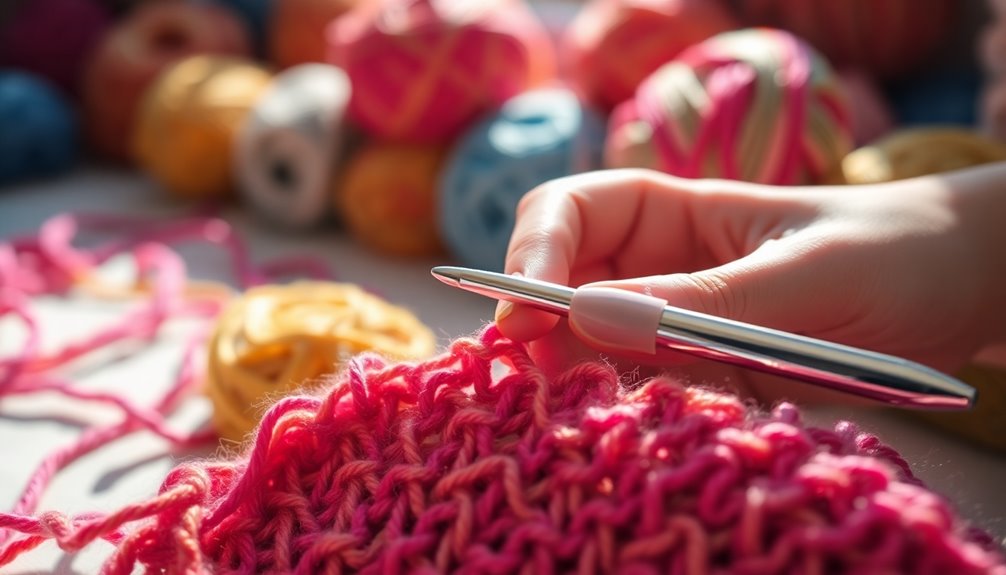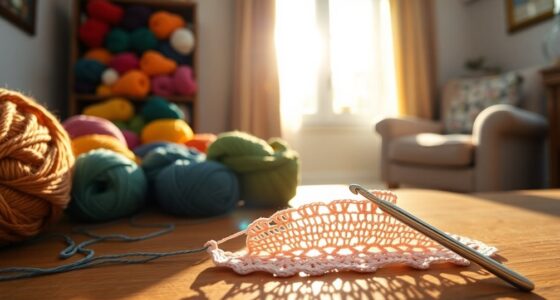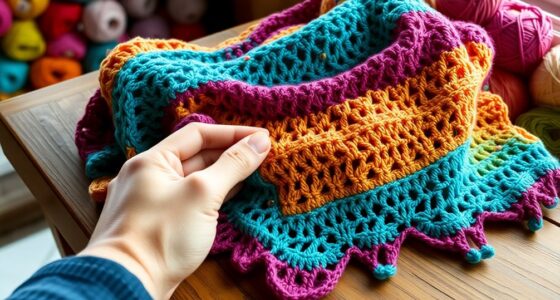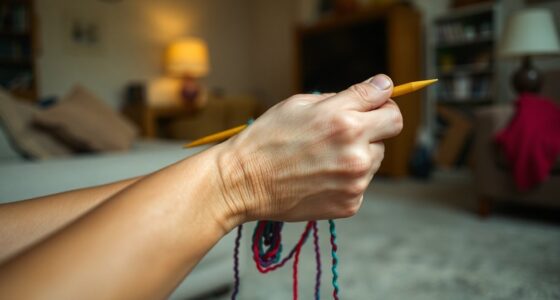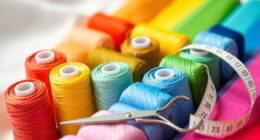In crochet, "SK" means "skip." It's an essential technique that lets you bypass specific stitches to shape your project and create beautiful patterns, especially in lacework. By skipping stitches, you can achieve airy designs, decrease stitch counts, and add unique textures to your work. Mastering this abbreviation helps enhance your crochet skills and guarantees you follow patterns accurately. Stick around to uncover more tips and tricks to perfect your crocheting techniques.
Key Takeaways
- "SK" in crochet means "skip," instructing the crocheter to bypass specific stitches in a pattern.
- Skipping stitches is essential for creating shapes and maintaining stitch count in crochet projects.
- The technique is commonly used in lacework to achieve open, airy designs in lightweight garments.
- Understanding "SK" is crucial for accurately following crochet patterns and achieving the desired visual appearance.
- Mastery of skipping stitches can enhance both the functionality and aesthetics of various crochet items.
What Does SK Mean in Crochet?
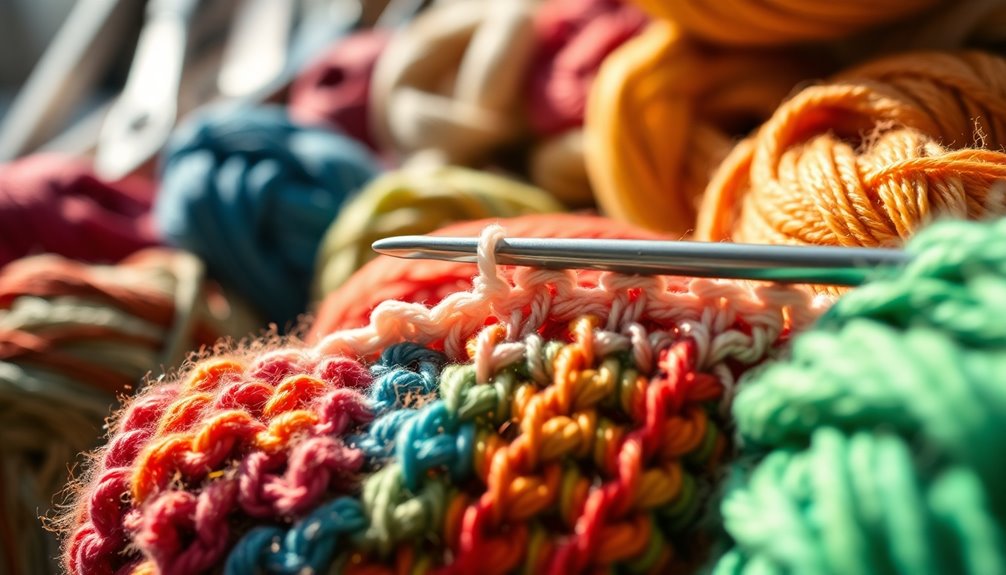
When you're diving into a crochet pattern, you might come across the abbreviation "sk," which stands for "skip." This instruction tells you to bypass a specific stitch or stitches, and it plays a crucial role in shaping your project.
Understanding "sk" is essential, as it can dramatically affect your stitch count and the overall appearance of your work. When a pattern tells you to skip stitches, it often aims to create open, airy designs, especially in lacework.
You might also use "sk" functionally for buttonholes or to sculpt garment pieces. By mastering this crochet term, you'll enhance your creativity, allowing for greater versatility and intricate designs in your projects.
Skipping stitches truly opens up a world of possibilities!
Uses of Skip in Crochet
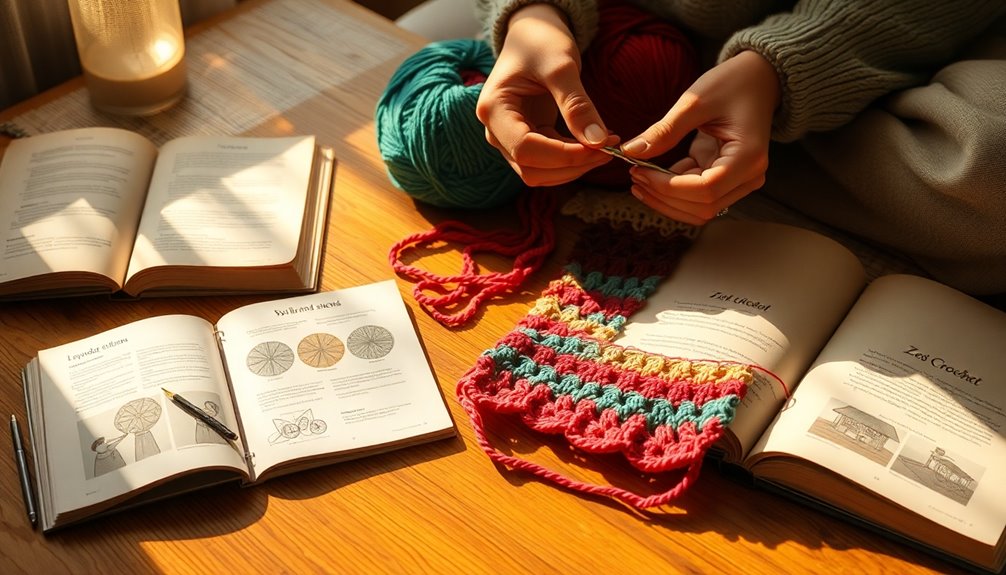
Skipping stitches in crochet serves multiple purposes that enhance both functionality and aesthetics in your projects.
Here's why you'll want to master this technique:
- Create Lacy Designs: Skip stitches introduce airy chain spaces, perfect for shawls or decorative motifs.
- Buttonholes: Use a skip stitch to form practical openings without compromising your garment's structure.
- Adjust Stitch Counts: Skipped stitches can decrease overall stitch counts, essential for shaping items like hats and sweaters.
- Flexibility in Patterns: Combine skipping with other stitch instructions to craft unique textures and patterns.
When you learn to crochet and work the instructions carefully, you'll find skipped stitches are a foundational skill that brings your projects to life, stitching together beauty and functionality.
Understanding Patterns
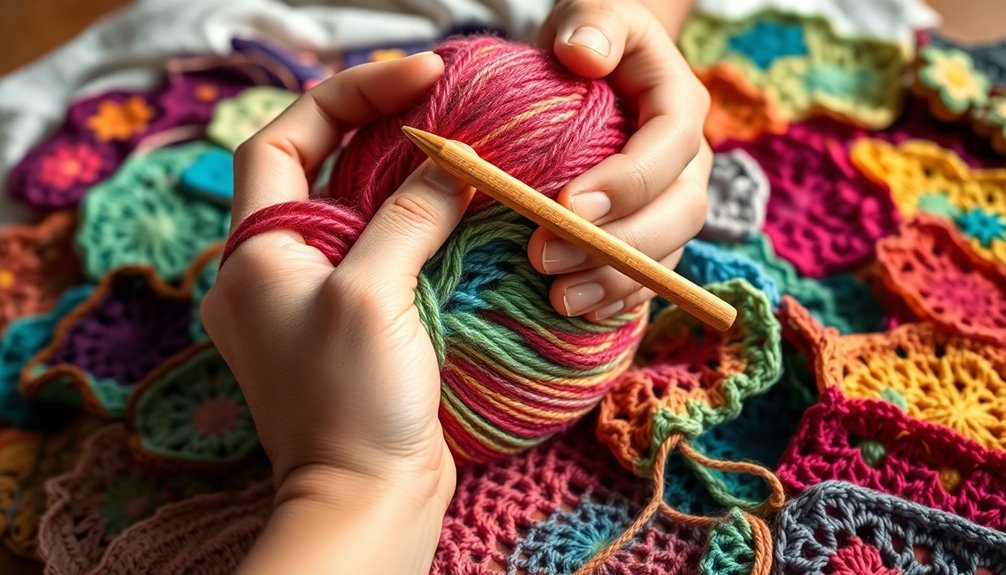
When you're tackling a crochet pattern, understanding the terminology is key to your success.
You'll often encounter instructions that include abbreviations and symbols, so getting familiar with these can make a big difference.
Crochet Pattern Terminology
Crochet patterns are like a secret language, filled with abbreviations and symbols that guide you through your project. One key abbreviation you'll encounter is "sk," meaning to skip stitches. Understanding this term is vital for achieving beautiful designs.
Here are some key points about crochet pattern terminology:
- Skip stitches can create decorative gaps for lace patterns.
- Parentheses and brackets clarify instructions, enhancing your understanding.
- Mastering abbreviations like "sk" simplifies reading patterns, making your project smoother.
- Understanding context is significant, as it affects stitch count and appearance.
Embrace these terms, and you'll find your crochet journey much more rewarding!
With each stitch, you're revealing new creative possibilities in your crochet patterns.
Reading Crochet Instructions
Understanding crochet patterns is key to successfully completing your projects. Familiarity with crochet abbreviations, like "sk," which means to skip a stitch, is essential for proper execution.
As you read crochet instructions, pay close attention to parentheses and brackets; they clarify how many stitches to skip or group together for better understanding.
Before diving into your project, take a moment to read pattern notes carefully. They often provide vital insights into how skips and other techniques shape the overall project design.
Misprints can cause confusion, so don't hesitate to review patterns thoroughly or consult additional resources.
With practice, you'll gain confidence in reading crochet patterns, gradually tackling more complex designs involving various stitches and techniques.
Tips for Reading Patterns
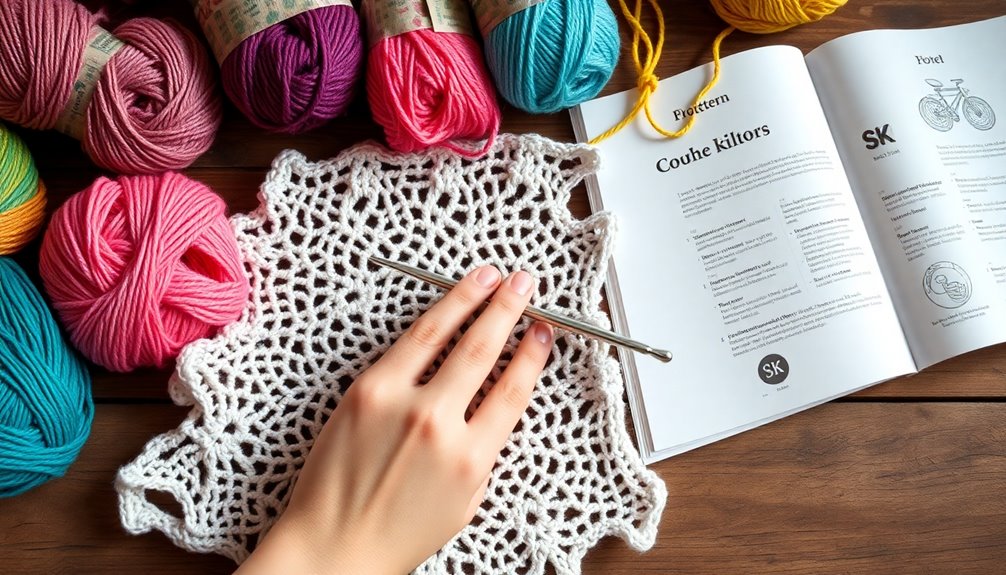
When you're reading crochet patterns, it's crucial to simplify complex instructions into bite-sized steps.
Focus on key symbols and abbreviations to streamline your understanding.
Using visual aids like video tutorials can also help clarify tricky techniques and make your crocheting experience smoother.
Simplify Complex Instructions
Reading crochet patterns can seem intimidating, especially with all the abbreviations and instructions involved. To simplify complex instructions, keep these tips in mind:
- Understand abbreviations like "sk" for skip; it can make your life easier.
- Pay attention to punctuation marks; they break down instructions and help you stay on track.
- Use stitch markers to visually indicate where to skip stitches, making it easier to count your stitches.
- Practice reading patterns with simpler designs before tackling more complex ones.
Always review the pattern notes carefully before you begin.
With practice, you'll confidently navigate chain stitches and stitches worked in rows, making crochet a more enjoyable experience!
Focus on Key Symbols
Key symbols in crochet patterns serve as your roadmap to success. Understanding abbreviations like "ch" for chain and "sk" for skip is essential for accurate execution.
Asterisks (*) guide you on which steps to repeat, while parentheses ( ) group stitches to work together, clarifying complex instructions. Brackets [ ] tell you how many times to repeat a step, making intricate patterns manageable.
Pay attention to the turning chain; it may or may not count as a stitch, depending on the pattern. Recognizing these symbols helps maintain correct stitch counts and guarantees your project turns out just as you envisioned.
With practice, you'll navigate your crochet patterns with confidence and ease.
Use Visual Aids
Understanding symbols is just the beginning of mastering crochet patterns. To enhance your pattern comprehension, incorporate visual aids that clarify complex stitch instructions.
Here are some tips:
- Use diagrams and charts to visualize crochet stitches.
- Employ stitch markers to easily indicate where to skip stitches.
- Color code sections of your pattern to differentiate instructions.
- Create a visual reference guide for common crochet abbreviations like SK.
Additionally, don't underestimate the power of video tutorials. They can show you how to execute patterns and demonstrate specific techniques for skipping stitches.
Applications of SK in Crochet Projects
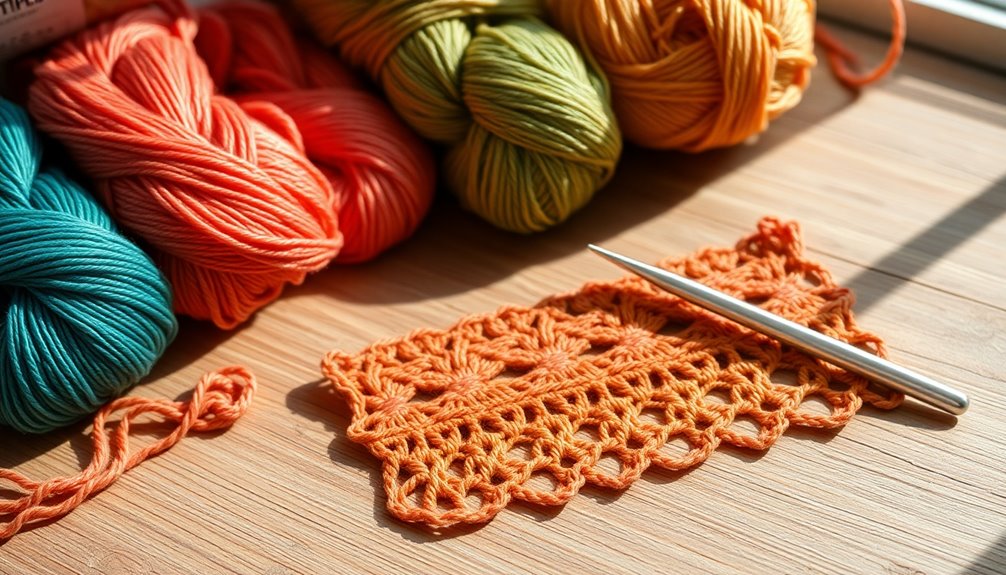
Incorporating the SK technique into your crochet projects opens up a world of creative possibilities. By skipping stitches, you can create lacy effects that enhance visual interest and showcase unique textures. This method is particularly useful when working on lightweight garments like shawls or summer tops. It allows you to shape your projects without adding bulk, making it perfect for buttonholes or adjusting the fit of accessories like hats and mittens.
| Application | Description | Benefits |
|---|---|---|
| Lacy Designs | Utilizing chain stitch and SK | Creates airy patterns |
| Shaping Techniques | Skipping stitches for increases/decreases | Maintains garment structure |
| Buttonholes | SK for functional openings | Easy access |
| Accessory Fit | Adjusting number of stitches | Comfortable wear |
Troubleshooting Common Issues With SK

While working with the SK technique in crocheting, you might encounter some common issues that can disrupt your project's flow. Here are a few to watch for:
- Uneven gaps: Verify you're consistently skipping the correct number of stitches.
- Misalignment of stitches: Losing track can lead to a mess; use stitch markers to help.
- Tight or stiff fabric: Adjust your tension or yarn choice if skipping stitches exaggerates these issues.
- Confusing patterns: Break down instructions and repeat them slowly to avoid errors.
When troubleshooting skipped stitches, double-check your starting and turning chains.
Remember to read a crochet pattern carefully and look at your pattern to verify you're skipping the right stitches to maintain your project's integrity.
Tips and Tricks for Flawless SK Execution

To achieve flawless execution of the SK technique, it's crucial to stay organized and focused on your pattern. Use stitch markers to highlight the stitches you plan to skip, as this helps maintain accuracy.
When working a double crochet stitch, remember that skipping the first stitch counts as the first in your pattern. Practice skipping stitches on a test swatch to build confidence.
Regularly count your stitches after each row to guarantee consistency; this prevents accidentally skipping too many or too few. Pay attention to common issues, like uneven tension—practice maintaining consistent tension for a polished finish.
Frequently Asked Questions
What Does SK Mean in Crochet?
In crochet, "sk" means "skip." When you see this in a pattern, it tells you to bypass a certain stitch or stitches.
This technique's essential for creating various designs, especially in lacework or shaping elements. By skipping stitches, you can form gaps or decorative effects that enhance your project.
Just remember, skipping stitches can also affect your overall stitch count, so be sure to follow the pattern closely for the best results!
What Is the K Symbol in Crochet?
When you spot the "K" symbol in a crochet pattern, it can feel like a puzzle piece that doesn't fit.
Unlike the crochet world where terms like "ch" and "dc" reign, "K" usually belongs to knitting. It might represent a unique stitch defined by the designer, so don't hesitate to check the pattern's legend.
Understanding these symbols will keep your crochet journey smooth and enjoyable, allowing your creativity to flourish.
What Does SSC Mean in Crochet?
In crochet, SSC typically stands for "Slip Stitch Crochet." This technique involves using slip stitches to create a smooth, flat fabric, perfect for joining rounds or finishing edges.
You might also encounter it as "Single Stitch Crochet," where you work a single crochet stitch into specified areas.
Mastering SSC is crucial for achieving a polished look in your projects, enhancing both texture and the overall aesthetic of your finished piece.
What Is KS in Crochet?
When you see "KS" in crochet, it might confuse you since it's not a standard abbreviation like "sk," which means skip.
While "KS" could suggest knit stitch, it's more often used in knitting. If you encounter "KS" in a pattern, check the legend for its specific meaning.
Understanding these distinctions is essential for your crocheting success, ensuring you follow patterns correctly and achieve the results you want.
Conclusion
Just like a skilled sailor navigates the waves, mastering the "SK" in crochet can steer your projects to success. When you skip stitches, you're not just following patterns; you're crafting your own journey through yarn. Embrace each skip as a leap toward creativity, where every missed stitch opens new horizons. With practice, you'll find that these small decisions can lead to beautiful, intricate designs, transforming simple threads into a tapestry of art. So, set sail—your crochet adventure awaits!
